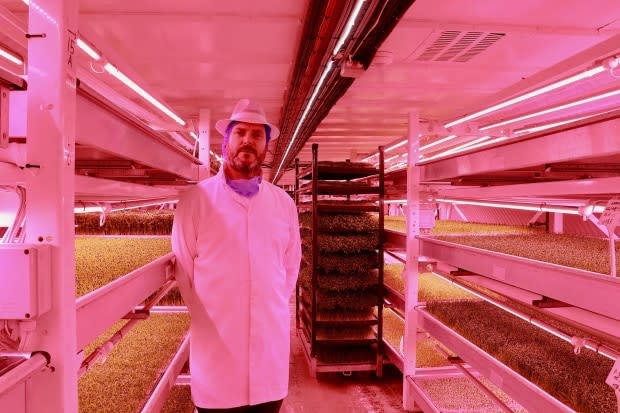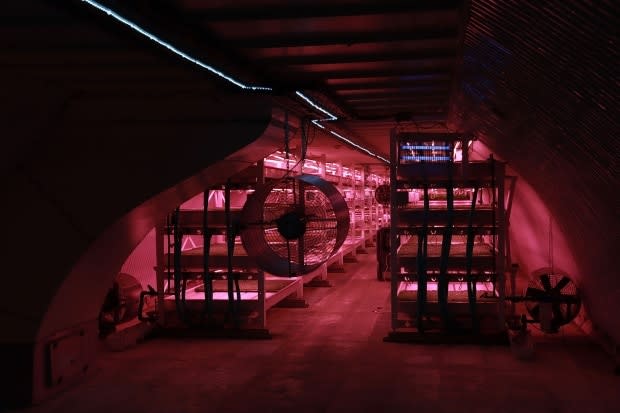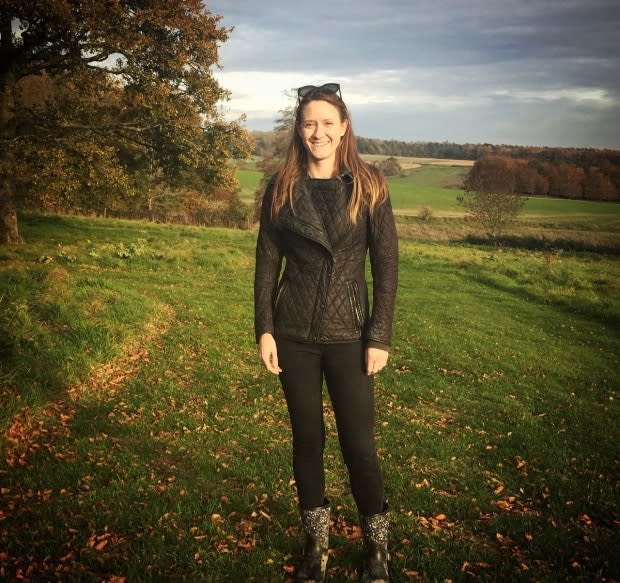A WW II bunker under London's streets is now a vegetable farm
Far below the streets of London exists an underground city of Second World War bunkers that were purpose-built in the event of an attack. When the war ended, these spaces were largely left empty.
Well, not all of them. In one of these shelters, 33 metres below Clapham High Street in southwest London, sits the world's first subterranean farm, called Growing Underground.
LED lights line two parallel rows of vibrant micro-greens and salad leaves, grown hydroponically in a pesticide-free, mineral-nutrient solution.
That means they grow in water, not soil. Radish, pea shoots, coriander, arugula and fennel, among other crops, are perfectly ordered in linear trays on recycled carpet.
The location is ideal because it's insulated from the rain, winds and cold temperatures that are commonplace in the U.K.
Growing Underground's co-founder, Richard Ballard, came up with the idea while completing his film degree in London a decade ago. He wanted to know what was going on below the streets of the city.

Around the same time, he became intrigued with the idea of vertical farming, which is a method of growing crops in vertically stacked layers indoors.
"An idea for a film got me researching the future of cities," Ballard said. "How are we going to feed and power them with the growing population, when we're estimated to have another two billion people on the planet in the next 30 years? And 80 per cent are expected to live in urban spaces?"
But London-based architect and author Carolyn Steel, an expert in the relationship between food and cities, questioned how widespread the reach of these farms may be. "Vertical farms are part of the solution, but I don't think they'll ever be the solution," she said.
"This is due to what I call the urban paradox — that being that cities don't feed themselves. And they never have done. What feeds a city is the countryside."
Farming in a controlled environment
The idea of vertical farming was the brainchild of Dickson Despommier, a professor of Public and Environmental Health at Columbia University in 1999. He believed it was the answer to many of the challenges faced by agriculture today, including climate change's impacts on crop yields, a lack of water and soil degradation from over-cultivation.
Dispommier's ideas inspired a generation of ambitious entrepreneurs like Ballard and his business partner, Steven Dring.
One of the benefits of the old bunker "is that we've got 100 feet of soil above us, so it's very insulated. This gives us a consistent temperature year-round that's ideal for growing crops," Ballard explained.
"We may use a little bit more energy because we're using LED lights, but we get a lot more yield for that. One example we give is pea shoots. If you were to grow them outside, you would get three or four harvests a year. In a greenhouse, you get 25 to 30. But in a controlled environment like our farm, you get 60."
Ballard said there are a number of other benefits to vertical farming. They include using less water, because it's recirculating in the system; no need for pesticides; it doesn't take up more land; and it's powered by renewable energy.

He also mentioned that because the produce is grown right in the city, there are fewer transport emissions and it can get to people's homes faster, increasing shelf life.
The company's goal is to become carbon neutral by the end of 2020, and by using carbon offsets, Ballard said the business will be a part of a "post-carbon economy."
'Silver bullet fix that doesn't exist'
Hydroponics isn't new, and has been widely used in commercial greenhouses worldwide. But the first commercial vertical farm wasn't opened until 2012 in Singapore, three years before Growing Underground. They're now dotted across the globe, with many in the U.S. and some farms in Canada, including TruLeaf, which is based in Nova Scotia.
What sets Growing Underground apart is that it's the first farm of its kind to open underground. It's also the first in the UK to sell its produce to major supermarkets, including Waitrose, Whole Foods and Planet Organic.

As innovative as this sounds, Honor Eldridge, the head of policy at the U.K.'s Sustainable Food Trust, said she thinks traditional agriculture will always play a role and needs to change, too.
"We need to take a step back and think, what are the systemic issues within our food and farming system, and is this really the technological fix that we want?" Eldridge said.
"It's a lot sexier to support and fund something when it's so exciting and new, but we're on the lookout for a silver bullet fix that doesn't exist."
Eldridge said that repairing soil is a key ingredient of climate action, and the lack of its use in vertical farming is problematic.
"For sustainable agriculture to thrive we need to work on improving soil health, by which we mean improving soil organic matter, so that you're improving soil carbon levels. That draws more carbon from the air and locks it into the ground, which helps with climate mitigation," she said.
Healthy soils are more resistant to extreme temperatures, fluctuations in water levels, drought and flooding. They also produce food that has a higher nutrient density.
Eldridge said she is also concerned about the use of chemical fertilizer in hydroponics, "which in itself has environmental consequences, as fertilizer is typically made from nitrogen that is mined."
"That has geopolitical implications and environmental implications — so how sustainable is the supply chain?"
The changing nature of farming
Whether there is enough space for this sort of farming in urban areas is a factor, too. According to Carolyn Steel's calculations, if you tried to incorporate the amount of land required to feed a city like London into vertical farms, you'd need around 2,000 buildings, each 30 stories high with 10,000 square metres of floor space. And she doesn't see an economic case for this.
"Take grains, which are about 200 times less valuable per kilo than baby salad leaves. Look at photos of wheat and soy fields in Brazil, for instance. Where do those go?"

Steel acknowledged that Growing Underground is "a brilliant use of disused space and makes a great product." But she believes vertical farming works better for produce like micro-greens, herbs and lettuce leaves that don't need to be cultivated on such a large scale — exactly the products Growing Underground sells.
"I think the biggest benefit of bringing agriculture into cities is the capacity to educate people and get them involved in growing food again," she said.


